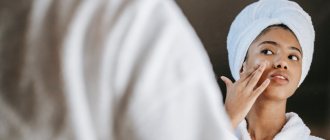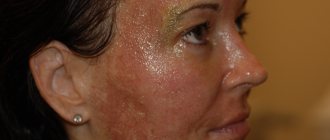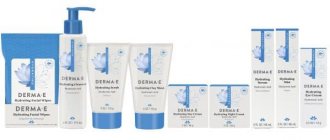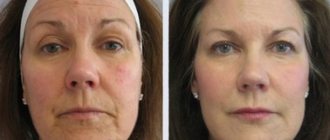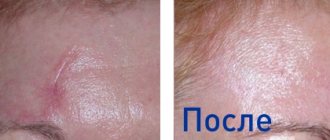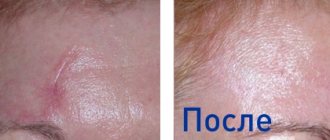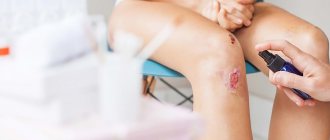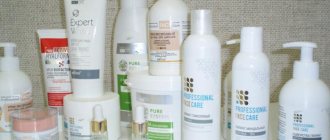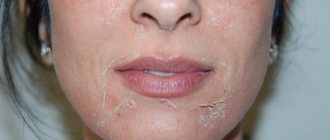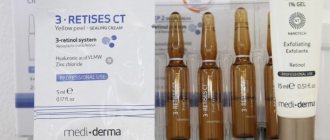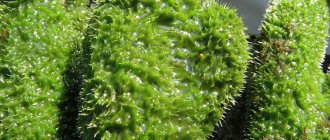An effective and even indispensable means of solving this problem is peeling of scars after acne treatment. At all times, even and smooth skin was considered one of the standards of beauty. But for many people, especially fair-haired and fair-skinned people, unpleasant formations in the form of acne (pimples and acne) can be so strong that even after getting rid of them, the skin cannot return to its normal state. The pockmarks, pits, and scars from treated acne give it a rough, bumpy, or pockmarked appearance in places.
Naturally, there are several (four in total) types of scars on the skin that appear due to other reasons - from skin damage from injuries and burns. But with cosmetic treatment methods, only two types of scars can be qualitatively smoothed and removed - normotrophic and hypotrophic. In more complex cases, it is already necessary to involve plastic surgery.
Since scars and skin irregularities, which are the insidious consequences of pimples and acne, are normotrophic manifestations, they can be effectively combated with the help of physical or chemical peeling.
Surgical methods
For chipped scars, the “punch excision” technique is used, in which each scar is cut out to the level of fatty tissue. There are different variations of this method. The defect heals after suturing or transplanting a piece of skin from another place. Transplantation may be required during operations on scars at the site of former fistula tracts. The wound heals within a few weeks.
For some scars (for example, “rectangular” and “rounded”), the subcision method can be used. With its help, they try to lift the scar above the underlying layers - due to the new scar tissue that forms at the site of the wound. To achieve a noticeable effect, 1-3 procedures can be performed. Swelling and pain after each one persist for 1-2 weeks. All surgical procedures are performed by a specialist surgeon under sterile conditions and under anesthesia.
Disadvantages of this procedure
Superficial milk peeling is a painless procedure, however, it is worth noting that after it, slight redness may normally appear at the application site and last from several hours to 3 days.
Superficial-medium and median peels can cause itching or burning, erythema after them lasts longer (from 2 to 14 days), temporary whitening of individual areas of the skin may appear - frost, which indicates a deep interaction with skin cells. Such deep peeling is not recommended to be carried out frequently; the frequency is determined by the condition of the skin and is carried out once or in courses once every six months.
Glycolic peeling
This type of exfoliation is based on glycolic acid, which can cleanse sebaceous ducts and rejuvenate the skin. Glycolic peeling is perfect for women over 30 who experience periodic rashes and post-acne. This procedure is superficial. It is carried out using a solution with a concentration of up to 25%. It is prescribed for problematic and oily dermis with single pimples. There is also a medium glycolic peel, which is used for serious structural changes and the presence of severe acne.
Exfoliation is carried out strictly according to a specific scheme. This takes from 20 minutes to half an hour. The procedure is performed only in winter and autumn.
Cream "Sledotsid"
This Russian-made product is intended to eliminate acne and prevent the appearance of scars. Manufacturers promise rapid restoration of the epidermis, the disappearance of any irregularities on the surface of the skin and red spots. This anti-acne cream contains hyaluronic acid and the anti-inflammatory substance sepen. The composition is also enriched with plant extracts. Its price is perhaps the lowest of all the above drugs. The instructions for use say that the greatest effect appears when using this product for two to three months.
HOW TO DO PEELING FOR CUTS AND SCARS AT HOME
It is impossible to get rid of large and old scars on your own. However, at home you can carry out superficial exfoliation, which will allow you to cope with fresh, small defects.
Badyaga with hydrogen peroxide
This mask promotes the resorption of small scars and alleviates acne. In combination with hydrogen peroxide, badiaga has the following properties:
- Exfoliates the stratum corneum of the epidermis;
- Has a slight irritant effect on cells, provoking their protective reactions and forcing them to regenerate;
- Stimulates elastin production;
- Has anti-inflammatory properties;
- Resolves neoplasms;
- Effectively disinfects.
For the mask, you need to mix badyagu with hydrogen peroxide in a 1:1 ratio and leave until foam appears.
The mixture is applied overnight in a thin layer. In the morning after washing, moisturizing is not required, but it is advisable to treat the skin with sunscreen.
Skin resurfacing at home
Scrubs will help eliminate scars at the initial stage. You can buy them or make them yourself. When preparing it yourself, honey, sour cream, kefir, and vegetable oils are usually used as a basis, to which ground coffee fruit seeds, sugar or oatmeal are added. Rub the scrubs into the skin with light movements for 1-2 minutes and rinse off.
You can also carry out grinding at home using special devices for the following actions:
- Brushing - removal of the stratum corneum using brushes, the depth of exposure is determined by the stiffness of the bristles;
- Diamond peeling - works based on a combination of a vacuum pump and diamond-coated grinding attachments;
- Ultrasonic cleaning breaks molecular bonds in cells, loosening and exfoliating the top layer of the epidermis.
Masks for imperfections
It's easy to make masks at home that will help make fresh scars less noticeable. Compositions made from the following ingredients have proven themselves to be best:
- Honey-lemon – heat the honey and mix it with lemon juice in a 1:1 ratio, apply to the problem area, leave for 15 minutes;
- Clay – mix the yolk, the juice of half a lemon and a tablespoon of clay appropriate to your skin type, leave the mixture on the skin for 10-15 minutes;
- Aloe – mix 1 tablespoon of aloe juice with 1 teaspoon of lemon, apply to the skin for 10 minutes.
Lotions and compresses
Lotions and compresses require a longer action of the composition than masks. And in the case of compresses, the effectiveness of the mixture is also enhanced by the warming effect. The following formulations will be most effective against scarring:
- Honey compress - mix 2 tablespoons of heated honey and 4 drops of lemon juice, apply the mixture to the skin, cover with cellophane and gauze, leave for 1-2 hours.
- Camphor compress - apply camphor oil to gauze, apply to the problem area and cover with cellophane, leave the compress overnight;
- Calendula and chamomile lotion - mix calendula, chamomile, yarrow, nettle, St. John's wort in equal parts. Pour 2 tablespoons of the mixture into a glass of boiling water and leave for 2-3 hours. Apply gauze soaked in the infusion to the scars for an hour 1-2 times a day.
Peels, in all their variety, are the main method of combating scar tissue. However, exfoliation is not a panacea. Products that are safe for use at home can only deal with small and fresh scars. More serious lesions require salon procedures with the participation of a specialist.
But if you approach treatment responsibly, starting peeling procedures on time and following all doctors’ instructions, the scars will disappear or become much less noticeable.
Text author: Alexandra Gribovskaya
Please leave a review if you have tried any treatments for scars and if they helped.
How effective is the procedure for face and body?
Peeling is a cosmetic lifesaver that will get rid of scars, potholes, bumpy areas on the face or any other area of the skin. The top layer of skin is removed, and new epidermal cells are formed in its place.
In cosmetology, a scar is understood as the consequence of skin tissue replacing its area after damage. There are five known varieties of it, and peeling can cope with all of them to varying degrees.
The condition of women's skin tends to change under the influence of many factors. Damage can also
- injuries;
- post-acne;
- stretch marks, etc.
The situation gets worse when the girl is waiting for the baby to be born. All the body’s resources are then directed towards pregnancy. This category of people suffers from two types of scar manifestations, among which stretch marks (stretch marks) are more common.
The effectiveness of peeling in such cases will depend on the type of scar and the characteristics of the manipulations performed. It works best with small formations or those that protrude from the surface. How to carry it out with maximum results and minimal harm?
Instructions and techniques for doing it at home
Mechanical facial peeling at home is a completely simple procedure. To remove the stratum corneum, home-made or industrial exfoliating compositions are used.
The massage begins from the center, after which the area of the nose, forehead and chin is massaged:
- Cleanse the skin with your usual cleanser.
- Apply scrub to damp skin and perform a light massage.
- Place a moistened napkin on your face.
- Remove the product with warm water and tone the skin.
- Apply nourishing cream or mask.
Care:
- You are allowed to wash your face no earlier than 12 hours after exfoliation.
- You can't wear makeup for six days.
- Do not visit the sauna, solarium or use sunscreen for three months.
- Do not use cosmetic products with alpha hydroxy acids and vitamin A.
Review of ointments and creams for scars
In modern medicine, pharmaceutical ointments are often used to remove acne scars on the body and face. Their peculiarity is the presence in the composition of various healing substances (panthenol, allantoin, urea and others). They activate metabolic processes in the skin and help restore damaged tissue faster.
| Name | Composition and indications |
| Contactubex | A well-known ointment for the treatment of keloid scars. Prescribed to slow down the formation of scar tissue and normalize metabolism. With regular use, it can remove small scars and stretch marks in a short time. The composition includes allantoin and plant extracts. |
| Dermatix ultra gel | This drug is one of the silicone products needed to dissolve incipient scar tissue. Can completely remove developing scars and reduce old ones. |
| Salicylic ointment | In medicine it is used to eliminate inflammation, soften the skin, and disinfect. Due to these properties, it is used to reduce the size of keloid scars. It is not able to completely eliminate dead tissue, but will help as an auxiliary medicine. |
| Mederma | Widely used to correct atrophic scars. The product contains allantoin and cephalin. With regular use, it softens hypertrophied tissues. Prevents the appearance of scars after operations and diseases (chickenpox, rubella). |
Are there any contraindications and side effects?
Any type of exposure is contraindicated if you have individual characteristics of the body.
The first item on the list will be the tendency to develop keloid scars or their current presence.
The use of hardware and chemical methods of deep cleansing is excluded in the following cases:
- cardiovascular failure;
- kidney diseases;
- hepatosis and hepatitis, fibrosis, liver failure;
- hypertension;
- disorders of the central nervous system;
- oncology at all stages.
Almost all types of peeling are prohibited:
- during pregnancy and breastfeeding;
- detection of type 2 diabetes;
- detection of rosacea, rosacea;
- manifestation of allergic reactions to special compounds.
Side effects can occur even in apparently healthy people in the form of the following manifestations:
- Erythema is intense redness that does not go away for several days. The aggressiveness of the composition and technique affect its durability and color form:
- the effect of alpha-hydroxy acids lasts 3 hours;
- TCA - 5 days;
- laser and deep types of peeling - up to 8 weeks.
- Peeling.
- Edema. They often appear after using an acidic compound and occur after the first day.
- Darkening of the skin. Lasts up to half a month.
- Marbling of skin tone.
- Infectious complications. Treatment and duration depend on the severity of the disease.
Causes of scars
There are, of course, appearance features determined by nature itself, which are most often easily corrected without the intervention of plastic surgeons. But there are also pronounced defects in the form of scars that appear as a result of thermal burns, injuries, inflammations that deeply affect the epidermis, and skin diseases.
They occur in people of different ages and can be observed in both women and men. Moreover, despite the popular belief that scars are an adornment for the stronger sex, the latter are not very happy about them, trying to get rid of them in any way.
How to get rid of scars after acne - post-acne treatment
More often than other procedures for post-acne, laser resurfacing and fractional laser rejuvenation are prescribed, especially if scar changes are diagnosed that are difficult to correct with other methods.
To smooth the skin texture, cleanse and tighten pores, peelings are prescribed:
- chemical (salicylic, glycolic, trichloroacetic, azelaic, fruit acids, TCA peeling and Jessner peeling);
- ultrasonic peeling;
- laser peeling.
If there are small, shallow scars, TCA peeling will help achieve a good effect. In addition, it (in agreement with the cosmetologist) is sometimes used as an additional method, along with laser treatment.
The procedure is a medium chemical peel, the effect of which is based on trichloroacetic acid, applied to the skin in a thin layer for several minutes.
This technique launches active cell renewal processes. To achieve the desired result, several sessions are necessary, the intervals between which will be determined by a specialist (as a rule, treatment lasts several months). It should be noted that exposure to trichloroacetic acid will require a 4-7 day recovery period, during which the skin will peel and peel. In addition, in order to avoid the development of hyperpigmentation, it is advisable to plan the procedure for the cold season.
Plasma therapy and mesotherapy are effective against scars.
Plasma therapy, PRP therapy RegenLab is an injection technique for introducing autoplasma into the dermis, prepared from the patient’s own venous blood, purified and enriched with platelets. The purpose of the procedure is to stimulate cell regeneration, restore damaged tissues naturally, renew and rejuvenate the skin by stimulating the body’s own resources.
The latest cellular technology for treating acne, scars, combating age-related skin changes, skin biostimulation, improving skin structure and rejuvenating body skin.
The purpose of the procedure is to restore the immune properties of the skin, treat acne, scars and rejuvenate aging skin.
Advantages:
— Short rehabilitation period
— Less painful procedure than ablative laser therapy and peelings
— The effect of the procedure is visible almost immediately
— Absolute safety (does not cause allergic reactions or inflammation; on the contrary, it has a powerful anti-inflammatory effect)
During mesotherapy, therapeutic cocktails with vitamin A are injected under the skin (to speed up regeneration processes, they do an excellent job with enlarged pores) and hyaluronic acid (for additional production of collagen and elastin, helps with scar healing).
In each specific case, the method of treating post-acne scars is chosen by a dermatologist-cosmetologist individually.
Sign up for a free consultation with a doctor for digital skin diagnostics at the SOLA Clinic of Aesthetic Medicine and Cosmetology, during which you can ask all your questions and choose an individual post-acne treatment plan.
What type of peeling procedure is most effective for skin scarring?
The effectiveness of peeling in some cases reaches more than 90%, according to specialists from the State Autonomous Institution of Medical Sciences in Volgograd. Let's consider those types of procedures that have proven themselves to be the best.
Laser
Laser grinding is divided into two types depending on the object of application. These could be options:
- Classical. Aimed at fibrous tissue and evaporating excess moisture from it.
The healthy layer of the skin is not affected. Cells that remain dried out are then removed without leaving a trace. Pros: precision execution, stimulating the skin area to regenerate in an easy way. - Fractional. It triggers the renewal mechanism of the epidermis through the production of collagen and accompanying elastin. As a result of such grinding, the scar is practically no different in appearance from the surrounding tissues.
The use of laser is successfully combined with other procedures, such as photorejuvenation. One of them will reduce the defect in size, and the other will work at a deep level.
The first session will show visible results, but in order to improve the quality of service, it is recommended to use the course for 1–2 months with an average of 10 appointments.
If possible, choose an erbium laser. This method is more gentle and is suitable even for thin skin.
Physical
Renews skin cells not only on the surface, but also in depth through abrasives. Dermabrasion and microdermabrasion will eliminate hypertrophic and atrophic types of scars. Essentially, this is the mechanical action of a nozzle with fine abrasives that smoothes out the problem area. This is many times more effective than using scrubbing agents at home.
Cosmetologists define the optimal time for using this type of procedure as 10 sessions every week.
The disadvantages include a large list of contraindications:
- allergic manifestations;
- initial stage of oncology;
- inflammation of the skin;
- pregnancy status;
- tanned surface of the epidermis.
Chemical
This includes a group of peels based on acids and alkaline compounds, which change pH and weaken the connecting pathways between particles of the stratum corneum. There are several stages of exposure to this composition:
- superficial;
- median;
- deep.
Only the last two types help with ordinary scars.
High-quality application of the TCA drug (a compound of trichloroacetic acid and glycolic acid) ensures its uniform penetration deep into the skin. The procedure has an effect that is an order of magnitude higher than just glycolic peeling . One application gives a certain effectiveness, but does not cancel pain relief and the subsequent necessary rehabilitation course.
The optimal solution, from the point of view of cosmetologists at the Moscow Art Plastic clinic, is 3-5 sessions after a month of waiting.
Phenol peeling works due to the presence of 50% of the substance of the same name in the composition applied to the client. The manipulations are effective, but also so painful that they require the administration of anesthesia of varying intensity. Recovery will take several weeks, and the patient should not be in direct sunlight. New layers of skin may become incorrectly pigmented if you accidentally tan.
You should sign up for phenol peeling during the cold season, and best of all during your next vacation.
Traditional methods for removing scar skin changes
Small fresh scars can be removed at home using effective folk remedies:
- Mix 1 tbsp. l. salt (finely ground), soda and sour cream. Apply to cleaned scar area and massage gently. After 5 minutes, rinse off the mixture with acidified water;
- Prepare a solution of calcium chloride (5 or 10%), as well as baby soap. Apply several balls of the drug with a cotton pad. When the liquid dries, apply soap foam to the skin, massage until pellets and a “creaking” feeling under your fingers appear. Then wash your face with warm water and apply moisturizer;
- Stir 2 tsp. red clay Ghassoul, 1 tsp. honey, 1 tsp. lemon juice. Apply the composition to the scar and the skin around it, rub in gently, and then leave for 15 minutes. Rinse and apply moisturizer. If you have dry skin, add a little sour cream or vegetable oil to the mixture.
- Heat camphor oil in a steam bath, dip a piece of gauze into it, then apply it to the scar, cover with film and secure with a band-aid. Apply the compress at night and remove it in the morning.
There are many more ways to correct scars at home, but remember that they will only be effective for small and fresh defects. Before using the above recipes, it is recommended to consult a dermatologist or cosmetologist.
Various types of peelings are the main method of combating scars.
However, it should be understood that the cleansing procedure is not always effective, especially when it comes to home sessions. It is recommended to entrust scar correction to an experienced cosmetologist or dermatologist.
If you are planning to do this yourself using specialized means, then be prepared for all sorts of complications (burns, scars, allergies, hyperpigmentation, etc.).
Only a qualified specialist will select the most suitable type of peeling, taking into account the type of skin, type of scar, characteristics of the body, etc. Salon procedures will help reduce the severity of deep and long-standing defects.
Tips and recommendations from cosmetologists
It is impossible to restore smoothness to skin that has scars without competent consultation with a physician. Trying to carry out any procedures at home is dangerous, as is seeking the appropriate procedure from an unqualified performer.
In addition, home cleansing sessions may not bring the expected effect. Entrust scar correction to an experienced cosmetologist who will select the appropriate type of procedure for you according to your skin condition and type.
For those who are thinking about getting rid of scar tissue in a radical way, doctors at cosmetology clinics have prepared special recommendations:
- Sign up for a conversation at several institutions in the city. As a rule, they are carried out free of charge or for a minimal price. This way you can see the presence of a cosmetologist on the staff, his achievements, and whether the clinic or center has a license to conduct procedures.
- Prepare a medical history for a doctor’s appointment, be prepared for questions about allergies to medications and other features of your skin.
- Start with more gentle treatment methods, no matter how you try to speed up the process of getting rid of annoying scars.
- Do not touch the crusts of healing skin either with your hands or with the help of any means, especially alcohol-based ones, without instructions from a cosmetologist.
- Avoid hot showers and baths, aggressive cosmetics for the body and face. If you are planning to train at a fitness center, remind the specialist receiving you about this; he will tell you whether physical activity will harm you during the recovery period.
- Do not forget about the need to use antimicrobial agents for areas damaged by peeling. They will speed up tissue regeneration, start the metabolic process correctly and get rid of unwanted infections.
All skin defects that appear for mechanical reasons (bite, burn, sprain, etc.) have one common property: the younger they are, the better they are removed and the fewer marks they leave. Don't leave self-care for later to have smooth, beautiful skin for many years!
We recommend: Effective cleansing and rejuvenation of the skin using peeling. Pros and cons of this procedure
How much does it cost at the showroom?
The cost of the procedures directly depends on several factors:
- complexity and type of service;
- places where you receive help (large center, city location);
- treatment areas on the body (cheeks, forehead, décolleté);
- type of scar (some institutions add stretch marks here).
The cost varies according to the websites of different clinics:
- deep chemical peeling - from 4600 to 5500 rubles (not in the capital);
- TCA 25% - up to 13,300 rubles;
- laser resurfacing of scar tissue (from 1 cm) - from 4500–7900 rubles in other cities and from 19,000 rubles for the thigh and abdomen in Moscow and St. Petersburg.
The most rational approach would be to ask for help by phone or on the website of the center you plan to visit. You can do this right from home, and during live communication you will be told in detail about all the nuances of the upcoming actions.
